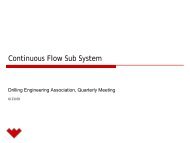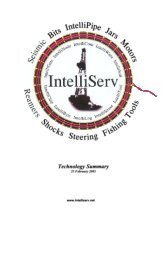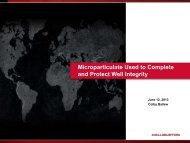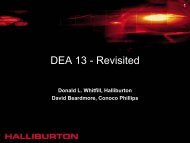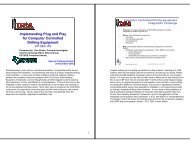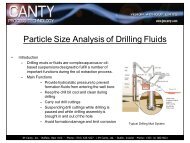JCPT-paper-on-Sag - Drilling Engineering Association
JCPT-paper-on-Sag - Drilling Engineering Association
JCPT-paper-on-Sag - Drilling Engineering Association
You also want an ePaper? Increase the reach of your titles
YUMPU automatically turns print PDFs into web optimized ePapers that Google loves.
FIGURE 9: Pressure changes for an unstable mud (mud C) whena pressure pulse was applied every 2.5 min between 1.5 and twohours.FIGURE 11: Pressure changes after three hours for the static,pressure pulses and pist<strong>on</strong> tests as a functi<strong>on</strong> of plastic viscosity.FIGURE 10: Pressure changes for a stable mud (mud A) when apist<strong>on</strong> was run up and down <strong>on</strong>ce every 2.5 min between 1.5 andtwo hours.Discussi<strong>on</strong>All the static tests are plotted in Figure 11 and 12. By varyingthe rheology and keeping the density within 1,400 to 1,600 kg/m 3 ,it is seen that this particular field mud will exhibit static stability,i.e., no settling in inclined pipes when the plastic viscosity is higherthan 20 cP and/or when the yield point is higher than 20lb/100ft 2 . The rheological parameters can thus be applied for predictingstability problems.When flow and static tests are plotted together as in Figure 13,it is seen that settling and sliding will occur at higher YP and PVin flowing muds than muds at rest.FIGURE 12: Pressure changes after three hours for the static,pressure pulses and pist<strong>on</strong> tests as a functi<strong>on</strong> of yield point.The following c<strong>on</strong>clusi<strong>on</strong>s may be drawn from this work:1. A laboratory apparatus was developed to investigate drillingmud instability leading to barite sag in inclined holes. It differentiatesbetween settling and sliding and between staticand flowing c<strong>on</strong>diti<strong>on</strong>s, and can be applied to determinewhen sagging will be initiated at static c<strong>on</strong>diti<strong>on</strong>s.2. Settling in static and flowing fluids is different. In flowingfluids the settling process will be exacerbated during laminarflow c<strong>on</strong>diti<strong>on</strong>s. Since the fluid has no gel strength whensheared it will behave like a power law fluid without yieldpoint, and as such produce a high effective viscosity at lowshear rates. At high viscosity, settling can be slowed downbut never fully avoided. Comm<strong>on</strong> API rheological parametersare necessary and suitable to estimate rheology for particlesettling.3. It has been shown that pressure pulses and pist<strong>on</strong> agitati<strong>on</strong>,simulating tripping, did not significantly influence theprocess of barite sagging.4. The 3 and 6 rpm Fann readings are unreliable because of theviscometer’s high relative error at those low speeds. PV andC<strong>on</strong>clusi<strong>on</strong>sFIGURE 13: Pressure changes at two or three hours as a functi<strong>on</strong>of PV for all tests.Special Volume I 5



